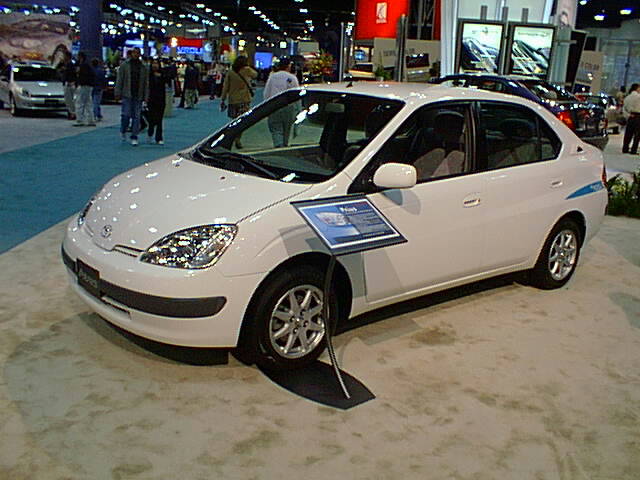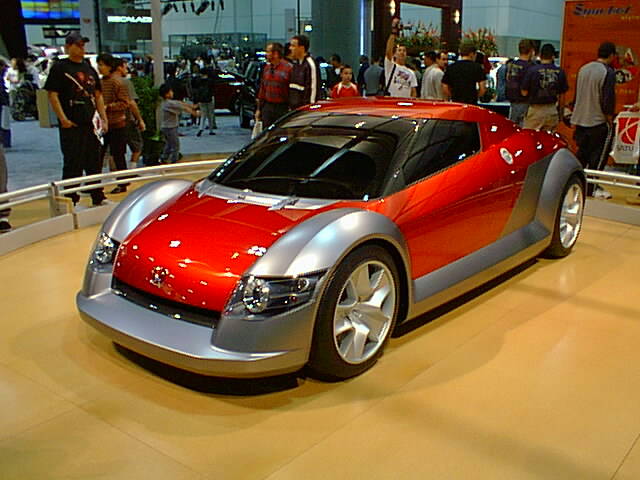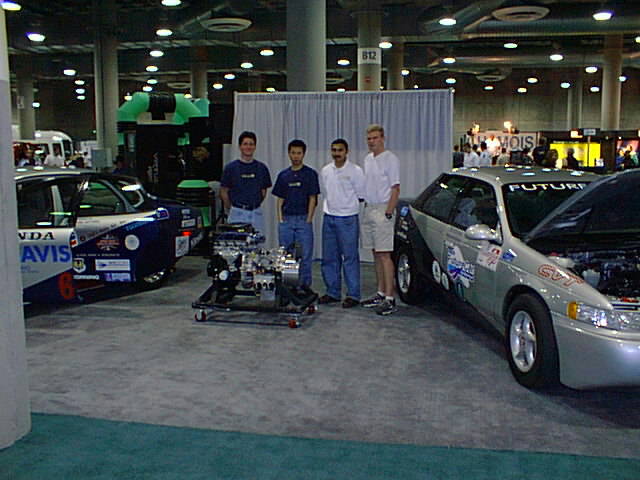
Home - AFV Events - Auto Shows - 2000 L.A. Auto Show
The theme of this year's Greater L.A. Auto Show is "California Dreamin' 2000"; from the perspective of alternative fuels and powertrains, though, I'd say the theme is "Hybrids Are Here!" My friends in the EV1 Club are gonna stone me for saying this, but it looks like 2000 will be the year of the hybrid-electric vehicle. A hybrid-electric vehicle is one that has both a combustion engine and an electric motor; the two can be independent, with one driving the front wheels and the other the rear wheels (parallel hybrid), or they can be integrated so that either the power of the combustion engine is fed through a generator to the electric motor (series hybrid) or the two share the job of driving a single pair of wheels through some kind of mechanical coupling (also called a parallel hybrid). This last classification is shared by the Honda Insight, which I first saw at the Anaheim Auto Show a few months back, and the Toyota Prius.

The two Priuses (Prii?) on display were both left-hand drive, ready for the U.S. market; all the ones I've seen before today have been right-hand drive Japanese models (it's been for sale there for a couple of years already). The Insight is expected in showrooms any day now, and the Prius this summer; watch this space for test-drive reports as soon as I'm able to rent an Insight or Prius from EV Rental Cars!

A sizable fraction of the concept cars on display were also hybrid-electric vehicles; this is the Honda Spocket (yes, I spelled that right), which is also a "hybrid" of a different sort, a mix of car and small pickup truck. The front wheels are driven by a gasoline engine, and there are also electric motors in the rear wheels.

The Mitsubishi SUW Advance (SUW stands for "Smart Utility Wagon") in the photo above is also a hybrid-electric vehicle, though I couldn't find anybody who had details of its powertrain. Ford and GM will also be introducing hybrid-electric concept cars, the Prodigy and Precept respectively, at the North American Auto Show in Detroit in about a week (hey, y'all, why not in L.A.? We need 'em more here!).

In another hall I found these folks, undergrads at UC Davis who are working on the school's Hybrid Electric Vehicle Research Program; left to right are Rob Kamisky, Ben Chung, Charnjiv Bangar, and Trevor Jones. The car on the left (behind the pillar) is "Joule," which started life as a 1996 Ford Taurus before being lightened with a composite body and fitted with a three-cylinder engine and electric motor. On the right is their current project, "Coulomb," a Mercury Sable that the factory used to test a lightweight aluminum body, fitted with a four-cylinder engine and electric motor joined with a continuously-variable transmission (CVT) like the setup on the stand in front of the guys.
The reason I joked above that the EV1 Club is going to shun me for talking up hybrids is that many battery-electric vehicle purists regard hybrid-electric vehicles as half-measures at best: since the electrical power is generated by the onboard engine rather than the much cleaner power grid, the pollution (unburned hydrocarbons, nitrogen oxides, carbon monoxide, and other poisons) from the vehicle is not necessarily much less than that of a very clean ordinary gasoline car, though the higher efficiency of the hybrid-electric drivetrain reduces fuel use and therefore greenhouse-gas (carbon dioxide) emissions--but again, not as much as a battery-electric. However, it is possible to design the car so that it is "battery dominant", meaning that most of the energy to power it (at least under some circumstances, say those that would be encountered in a moderate-length daily commute) comes from the battery pack, which can be charged by plugging in to the grid to reduce use of the combustion engine. This costs more money to build, because the vehicle needs a larger battery pack and the extra circuitry for plug-in charging, so the Insight and Prius do not have these features; but to increase efficiency and reduce pollution, the UC Davis folks have built their cars according to this design philosophy.

There was also in the same hall a sizable display of battery-electric vehicles of all kinds, fittingly called "EV Spectrum." In this photo you can see a large electric bus in the background, behind several kinds of smaller EVs from ZAPWORLD.COM (formerly ZAP Power Systems); in the foreground, left to right, are the Lectra electric motorbike and ZAPPY scooter, three Neighborhood Electric Vehicles from Global Electric MotorCars, and two ZAP electric bicycles (I have one of their kits on my own bike). There were also electric vehicles ranging from a riding lawnmower and a forklift to the TH!NK two-seat commuter minicar to the full-size Ford Ranger, Toyota RAV4-EV, and Dodge EPIC minivan. The point of this display was to showcase "pure" battery-electric vehicles, pointing out that there are many practical offerings out there in the market and that these are really a much better way to go for pollution reduction than the hybrid-electric vehicles now being offered.
My view on this debate? The reason that battery-electric advocates generally dislike hybrid-electric vehicles is that they think that accepting "half-measures" will lead people to abandon the all-around better pollution solution of battery-electrics; however, I think that this amounts to "letting the best be the enemy of the good." Wearing my EV1 jacket, I got asked a lot of questions when I was looking at the EV1 and the vehicles discussed above, and one of them was "which do you think will catch on in the next five or ten years, battery-electrics or hybrid-electrics?", to which I answered "both!" The gasoline refueling capability of the Insight and Prius greatly increases the consumer "comfort level" with these cars, and if gas prices and environmental concerns keep going up I expect them to do well in the marketplace; this in turn will increase production volumes and bring down costs for battery packs, motors, and electronic controls, which will benefit the battery-electric market as well. Then as more and more people realize that a battery-electric vehicle makes perfect sense as the primary car in the typical two-car household (with maybe a more conventional car for occasional long trips), the shrinking prices of these vehicles will help them break out of their niche too. The 10% zero-emission-vehicle mandate (10% of all cars sold in California, and in states that have adopted the California emission standards, have to be ZEVs) is still in place for the 2003 model year; looking at the state of things in the 2000 model year, I'm not too worried that it will be possible to meet it!

Finally, just to show that the whole show wasn't about electric and hybrid-electric cars, this is the Dodge Charger R/T concept car, which has a front-engine/rear-drive powertrain with a supercharged, natural-gas V-8 under the hood. Kind of like what I want to do with my ol' 1970 Chevy Caprice! My old friend the natural-gas-powered Honda Civic GX was there too. The whole point of alternative fuels is to have extra choices besides gasoline and diesel fuel; there's nothing to say that one particular extra choice is the way to go, and from what I've seen at this show and others, the automakers are heavily involved in exploring many different ones. Wasn't there some ad campaign somewhere with the tagline "Choice Is Good"?
 Back
to AFV Events Page
Back
to AFV Events Page Back
to Fueling Station
Back
to Fueling Station Site
Map
Site
Map Contact
Me
Contact
Me All content copyright 1998-2024 by Mark Looper, except as noted. Reuse of my copyrighted material is authorized under Creative Commons Attribution 4.0 International license (CC BY 4.0).
![]()
![]()
new 8 January 2000, revised 6 February 2001